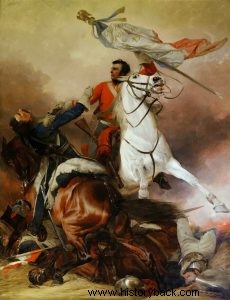
The regiment of the Royal Scots Grays was one of the oldest in the British Army. It was founded in 1678. It fought in the War of the Grand Alliance, the Spanish Succession, the Austrian Succession, the Septuagint and of course the wars of the French Revolution and the Napoleonic Wars.
The regiment got its name from the gray horses it used. However, when there was a shortage of horses, every available one was used. The regiment distinguished itself wherever it fought. In 1815, after Napoleon's escape from the island of Elba, the regiment, which then had a strength of 946 men, sent to Belgium about 600 of its men who, under Lieutenant-Colonel James Hamilton , joined the Duke of Wellington's army.
Together with the Royal Dragoons and Inniskillings Dragoons regiments they formed the famous Union Brigade under Major General Ponsonby. They took no part in the battle of Cut Bra, but were to win eternal glory at Waterloo.
The field of fate
On that morning of 18 June 1815 the Scots Grays were lined up on the left wing of the army as a reserve. The battle soon "fired up" and the French pressed the allied center (Wellington's army included British, Dutch, Belgians and men from the small states of Braunschweig, Nassau, Hanover and a few from other German states).
Immediately the British cavalry counter-attacked to support the hard-fought infantry. The Scots Grays were not ordered to attack but to remain in reserve. At about 1:30 p.m., however, Hamilton saw the 92nd Scottish Highlanders being suffocated by the French and in danger of being disbanded.
Then, on his own initiative, he ordered his regiment to attack. Because of the terrain not suitable for cavalry the Scots Grays did not attack at a gallop, but at a gallop, in formation. Even so, the hard-nosed Scots routed the opposing French infantry... the 92nd was saved.
Here is how a French captain describes the attack of the Scots Greys:“As I was pushing a soldier back into the line I saw him fall suddenly at my feet dead by a sword. I turned and saw the English cavalry cutting us to pieces... Our lines were broken and the cavalry slaughtered unmolested... We were defenseless... They slaughtered without marsh even the drummers"...
"The Scots Grays literally trampled the French phalanx" , reported an officer of the 92nd Highlanders. At that moment Sergeant Charles Ewart saw a Frenchman holding the banner of the 45th Infantry Regiment. He immediately rushed to grab it. “A (Frenchman) attacked me. I struck him on the head with the sword... I struck another with the sword from the jaw to the teeth... Another attacked me with the bayonet but I struck him on the head," said the sergeant after the battle, who grabbed the banner, the "eagle" with the number of the French regiment, earning a promotion to officer.
Advance until the horses run away
Having crushed the French attack the Scots Grays found themselves in the middle of the battlefield without a purpose. Logic would dictate that they retreat to their old positions and rest their horses. But the heat of the battle had taken its toll on the men, and neither Hamilton nor Ponsonby were able to rein it in . So the regiment, together with other regiments, instead of retreating, galloped forward.
The Scots Grays marched against General Durut's French infantry division. But the French caught up and formed squares and with their fire cut down the brave horsemen. However, in their attempt to fend off the Scots Greys, they found themselves unprepared against the 1st Regiment Royal Dragoons and suffered very heavy losses.
At the same time the Scots Greys, unable to "break" the blocks, attacked the French artillery causing overwhelming losses. At this stage the men saw Hamilton for the last time , who was apparently killed.
Pressing on constantly the Scots Grays found themselves before the main line of battle of the French army. The horses were exhausted from galloping and fighting, many of them wounded, and the losses were heavy. So when they received the counterattack of the French cavalry (pairmen and lancers), they found themselves in an extremely difficult position. Ponsonby was captured and cut to pieces by the French beyond the law of war .
The Scots Grays tried to save the major general but were unsuccessful. After this the British cavalry fell back to their original positions. The Scots Grays regrouped and supported Wellington's left wing infantry for the remainder of the battle. But they were now hopelessly few. Of the 416 who rushed, 104 were killed and 97 were wounded. 228 horses were also lost.
Nevertheless, at the end of the battle of Waterloo they were in the vanguard of the phalanx in pursuit of the defeated French. They continued to fight until the end of the war in July 1815 and remained in France as an occupying force until 1816.

"At that moment Sergeant Charles Ewart saw a Frenchman holding the banner of the 45th Infantry Regiment. He immediately rushed to grab it. "A (Frenchman) attacked me. I struck him with the sword on the head... I struck another with the sword from the jaw to the teeth..."
